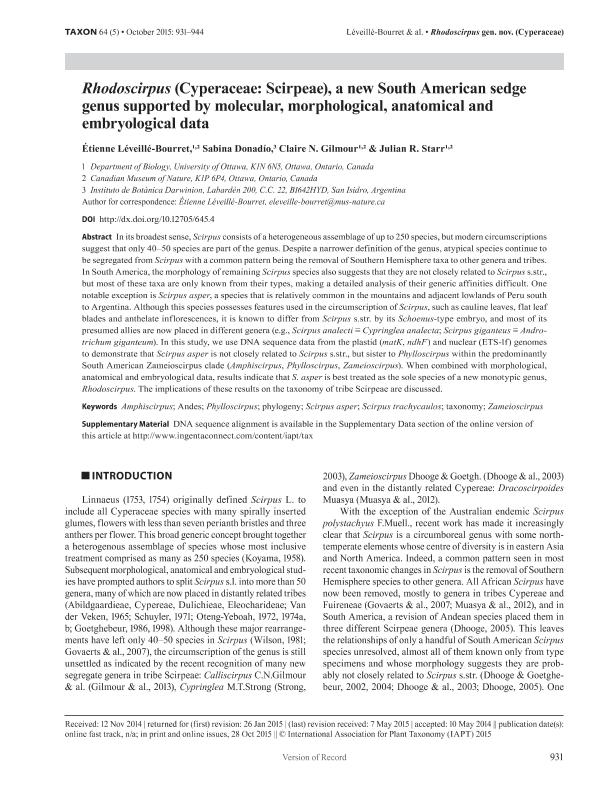Mostrar el registro sencillo del ítem
dc.contributor.author
Léveillé Bourret, Étienne

dc.contributor.author
Donadío, Sabina

dc.contributor.author
Gilmour, Claire N.

dc.contributor.author
Starr, Julian R.

dc.date.available
2017-06-28T19:57:48Z
dc.date.issued
2015-10
dc.identifier.citation
Léveillé Bourret, Étienne; Donadío, Sabina; Gilmour, Claire N.; Starr, Julian R.; Rhodoscirpus (Cyperaceae: Scirpeae), a new South American sedge genus supported by molecular, morphological, anatomical and embryological data; International Association for Plant Taxonomy; Taxon; 64; 5; 10-2015; 931-944
dc.identifier.issn
0040-0262
dc.identifier.uri
http://hdl.handle.net/11336/19049
dc.description.abstract
In its broadest sense, Scirpus consists of a heterogeneous assemblage of up to 250 species, but modern circumscriptions suggest that only 40–50 species are part of the genus. Despite a narrower definition of the genus, atypical species continue to be segregated from Scirpus with a common pattern being the removal of Southern Hemisphere taxa to other genera and tribes. In South America, the morphology of remaining Scirpus species also suggests that they are not closely related to Scirpus s.str., but most of these taxa are only known from their types, making a detailed analysis of their generic affinities difficult. One notable exception is Scirpus asper, a species that is relatively common in the mountains and adjacent lowlands of Peru south to Argentina. Although this species possesses features used in the circumscription of Scirpus, such as cauline leaves, flat leaf blades and anthelate inflorescences, it is known to differ from Scirpus s.str. by its Schoenus-type embryo, and most of its presumed allies are now placed in different genera (e.g., Scirpus analecti ≡ Cypringlea analecta; Scirpus giganteus ≡ Androtrichum giganteum). In this study, we use DNA sequence data from the plastid (matK, ndhF) and nuclear (ETS-1f) genomes to demonstrate that Scirpus asper is not closely related to Scirpus s.str., but sister to Phylloscirpus within the predominantly South American Zameioscirpus clade (Amphiscirpus, Phylloscirpus, Zameioscirpus). When combined with morphological, anatomical and embryological data, results indicate that S. asper is best treated as the sole species of a new monotypic genus, Rhodoscirpus. The implications of these results on the taxonomy of tribe Scirpeae are discussed.
dc.format
application/pdf
dc.language.iso
eng
dc.publisher
International Association for Plant Taxonomy

dc.rights
info:eu-repo/semantics/openAccess
dc.rights.uri
https://creativecommons.org/licenses/by-nc-sa/2.5/ar/
dc.subject
Amphiscirpus
dc.subject
Andes
dc.subject
Phylloscirpus
dc.subject
Phylogeny
dc.subject
Scirpus Asper
dc.subject
Scirpus Trachycaulos
dc.subject
Taxonomy
dc.subject
Zameioscirpus
dc.subject.classification
Ciencias de las Plantas, Botánica

dc.subject.classification
Ciencias Biológicas

dc.subject.classification
CIENCIAS NATURALES Y EXACTAS

dc.title
Rhodoscirpus (Cyperaceae: Scirpeae), a new South American sedge genus supported by molecular, morphological, anatomical and embryological data
dc.type
info:eu-repo/semantics/article
dc.type
info:ar-repo/semantics/artículo
dc.type
info:eu-repo/semantics/publishedVersion
dc.date.updated
2017-06-26T21:34:54Z
dc.journal.volume
64
dc.journal.number
5
dc.journal.pagination
931-944
dc.journal.pais
Austria

dc.journal.ciudad
Viena
dc.description.fil
Fil: Léveillé Bourret, Étienne. University of Ottawa; Canadá
dc.description.fil
Fil: Donadío, Sabina. Consejo Nacional de Investigaciones Científicas y Técnicas. Instituto de Botánica Darwinion. Academia Nacional de Ciencias Exactas, Físicas y Naturales. Instituto de Botánica Darwinion; Argentina
dc.description.fil
Fil: Gilmour, Claire N.. University of Ottawa; Canadá
dc.description.fil
Fil: Starr, Julian R.. University of Ottawa; Canadá
dc.journal.title
Taxon

dc.relation.alternativeid
info:eu-repo/semantics/altIdentifier/url/http://www.ingentaconnect.com/contentone/iapt/tax/2015/00000064/00000005/art00006
dc.relation.alternativeid
info:eu-repo/semantics/altIdentifier/doi/http://dx.doi.org/10.12705/645.4
Archivos asociados
